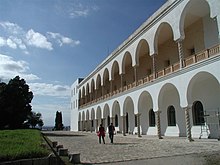Carthage National Museum
 |
|
| Established | 1875 |
|---|---|
| Location | Carthage, Tunisia |
| Coordinates | 36°51′12″N 10°19′26″E / 36.8533°N 10.324°E |
| Type | National museum |
| Website | The Carthage Museum |
Carthage National Museum is a national museum in Byrsa, Tunisia. Along with the Bardo National Museum, it is one of the two main local archaeological museums in the region. The edifice sits atop Byrsa Hill, in the heart of the city of Carthage. Founded in 1875, it houses many archaeological items from the Punic era and other periods.
The Carthage National Museum is located near the Cathedral of Saint-Louis of Carthage. It allows visitors to appreciate the magnitude of the city during the Punic and Roman eras. Some of the best pieces found in excavations are limestone/marble carvings, depicting animals, plants and even human sculptures. Of special note is a marble sarcophagus of a priest and priestess from the 3rd century BC, discovered in the necropolis of Carthage. The Museum also has a noted collection of masks and jewelry in cast glass, Roman mosaics including the famous "Lady of Carthage", a vast collection of Roman amphoras. It also contains numerous local items from the period of the Byzantine Empire. Also on display are objects of ivory.
The museum was founded in 1875 by Cardinal Charles Martial Lavigerie in the premises of the monastery; its name until 1956 was the Museum Lavigerie.
The museum is the product of excavations conducted by European archaeologists, in particular those made by Alfred Louis Delattre. The Annex was used at first to house the items found in searches in the necropolis of Carthage and excavations of the St. Louis hill but also Douimès, the hill of Juno, the Sainte-Monique Hill and also the Carthaginian Christian basilicas. However, many object unearthed were sold to tourists when the museum had a number of examples of similar objects.
...
Wikipedia
